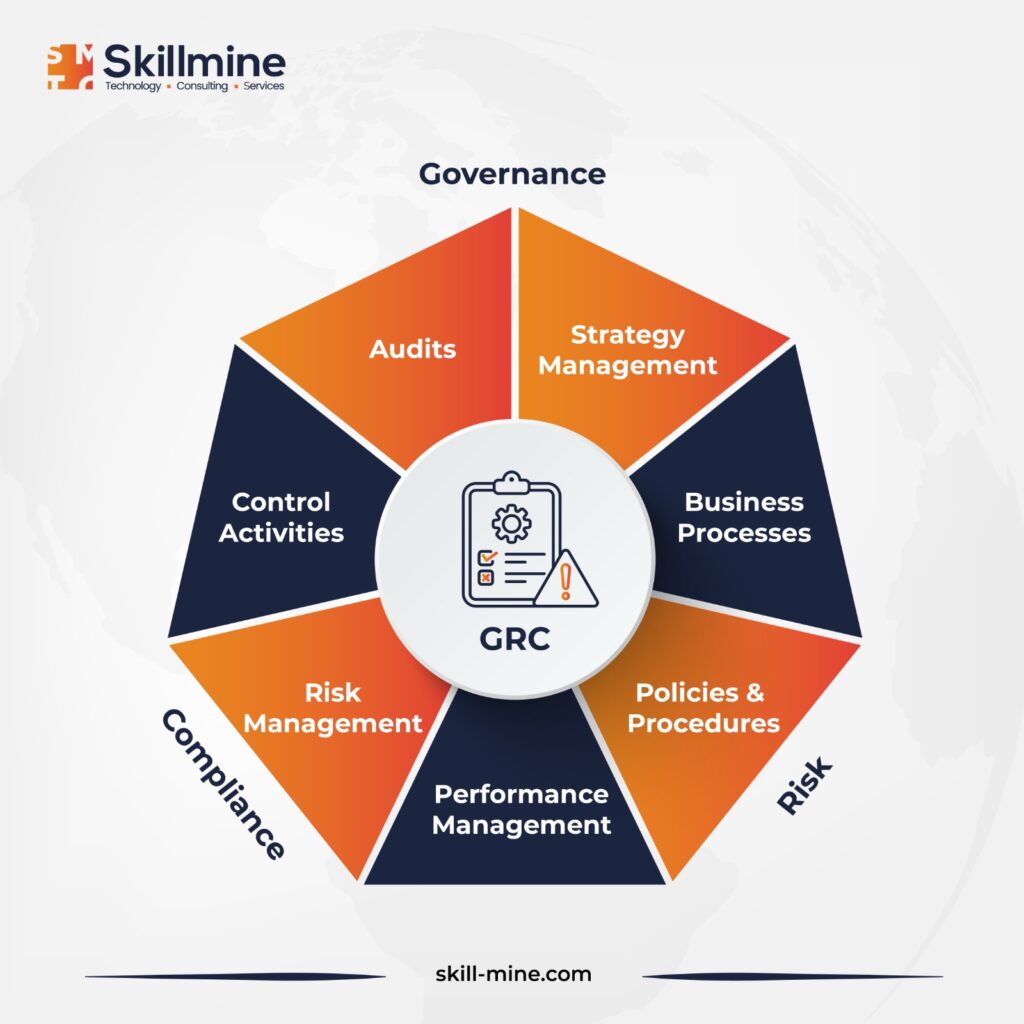According to KPMG, Third-Party Risk Management (TPRM) is a strategic priority for 85 percent of businesses. Weaknesses in the TPRM operating model are proving to be a major problem for businesses worldwide. 73% respondents said that they experienced at least one major disruption caused by a third party within the last three years. Let’s understand GRC and its relationship with TPRM.
What Does GRC Encompass?
IT GRC, or Information Technology Governance, Risk, and Compliance, is a management framework focusing on governing, managing risks, and ensuring compliance within IT systems. Governance involves establishing policies and controls for effective IT resource utilization. Risk management entails identifying and mitigating IT-related risks like cybersecurity threats.
Compliance ensures adherence to laws, regulations, and standards governing IT operations and data management. IT GRC aims to safeguard information assets, maintain operational integrity, and align IT activities with business objectives. Some of the best IT GRC tools play a crucial role in managing IT resources effectively, mitigating risks, and meeting regulatory requirements within organizations.

How is Third-Party Risk Related to GRC?
Third-party risk management (TPRM) serves as an outward-facing component of GRC. TPRM facilitates the identification and management of IT risks within the supply chain, including vendors, suppliers, and partners – collectively referred to as the extended enterprise. This ensures a satisfactory level of risk with partners and assesses vendors’ compliance with regulatory requirements.
TPRM automates the collection and evaluation of vendor-provided evidence through questionnaires, identifies and prioritizes vendor risks, offers remedial recommendations, continuously monitors cyber and business risks, and provides reports tailored to compliance standards or industry frameworks.
In essence, both GRC and TPRM share conceptual similarities in their approaches and outcomes, with TPRM benefiting from GRC by becoming more proactive and less reactive. Additionally, TPRM considers second and fourth parties within the extended enterprise framework.
Understanding Risks Associated with Third Parties
Interacting with third-party vendors and suppliers exposes organizations to a range of risks, including:
- Compliance Risks: Dealing with third-party relationships can present challenges regarding compliance, particularly if vendors do not comply with relevant laws, regulations, and industry standards.
- Operational Risks: Dependence on third parties can result in service disruptions, data security breaches, or failures in delivering goods or services, impacting the smooth functioning of an organization.
- Reputational Risks: The behaviour or misconduct of a third-party vendor can stain an organization’s reputation, leading to a loss of customer trust and potential harm to brand reputation.
- Legal and Financial Risks: Failure of third parties to adhere to laws and regulations can expose the organization to legal liabilities, penalties, and financial losses.
Incorporating Third-Party Risk Management into GRC
To effectively integrate third-party risk management into Governance, Risk, and Compliance (GRC) frameworks, organizations should consider the following strategies:
- Due Diligence: Conduct comprehensive due diligence assessments before engaging with third-party vendors. Evaluate their reputation, financial stability, compliance history, and security measures to ensure alignment with the organization’s risk tolerance and compliance needs.
- Contractual Agreements: Establish detailed contractual agreements that clearly outline roles, responsibilities, and expectations, including compliance requirements, data protection measures, confidentiality, and dispute resolution mechanisms.
- Continuous Monitoring: Implement processes to continually monitor and evaluate third-party performance and compliance. Regularly assess key risk indicators, financial statements, security measures, and adherence to contractual obligations.
- Risk Mitigation: Develop strategies and plans to mitigate identified risks. Implement controls and monitoring systems to reduce vulnerabilities associated with third-party relationships.
- Incident Response: Create an incident response plan outlining procedures for managing and responding to breaches, disruptions, or non-compliance issues stemming from third-party engagements.
Conclusion
An effective third-party risk management (TPRM) program goes far beyond mere onboarding procedures. Organizations must fully engage in the entire TPRM lifecycle, from inception to completion, to effectively manage risks. Skillmine facilitates third-party risk assessment through COMPLYment, a comprehensive IT GRC tool. This IT GRC software provides a unified compliance management and audit cycle for your organization. With Skillmine‘s platform, organizations can streamline the assessment process, identify potential risks more efficiently, and implement proactive measures to mitigate them effectively.
Looking for expert technology consulting services? Contact us today.





